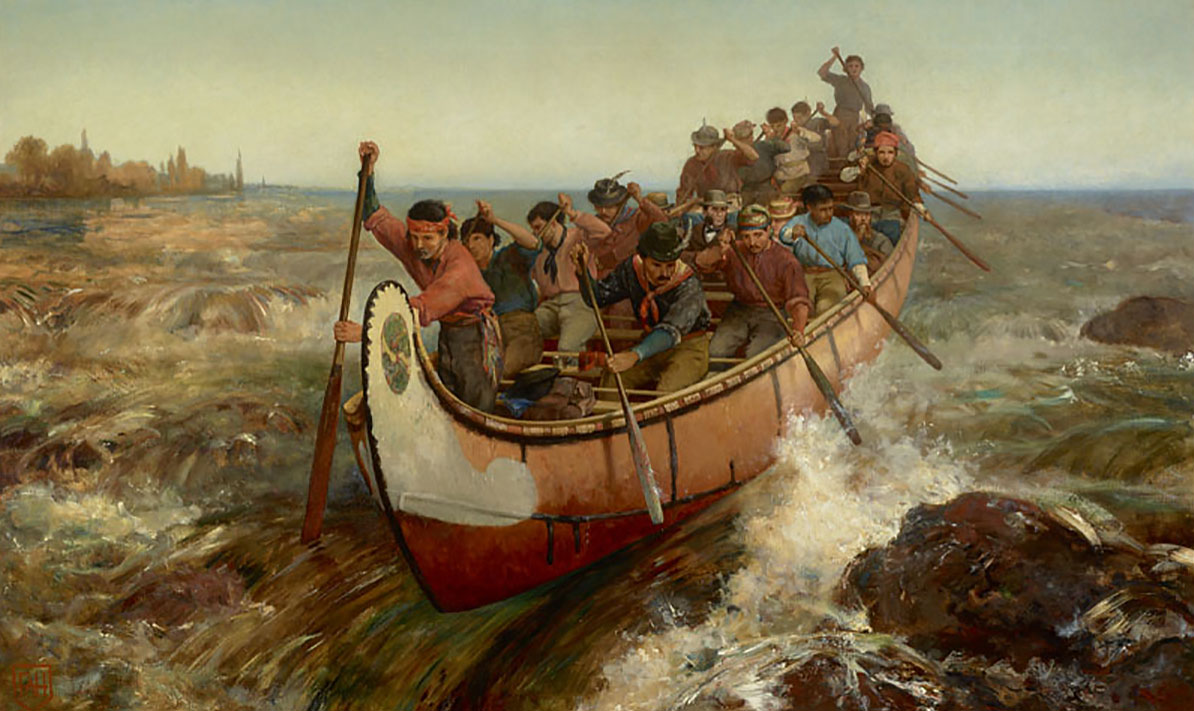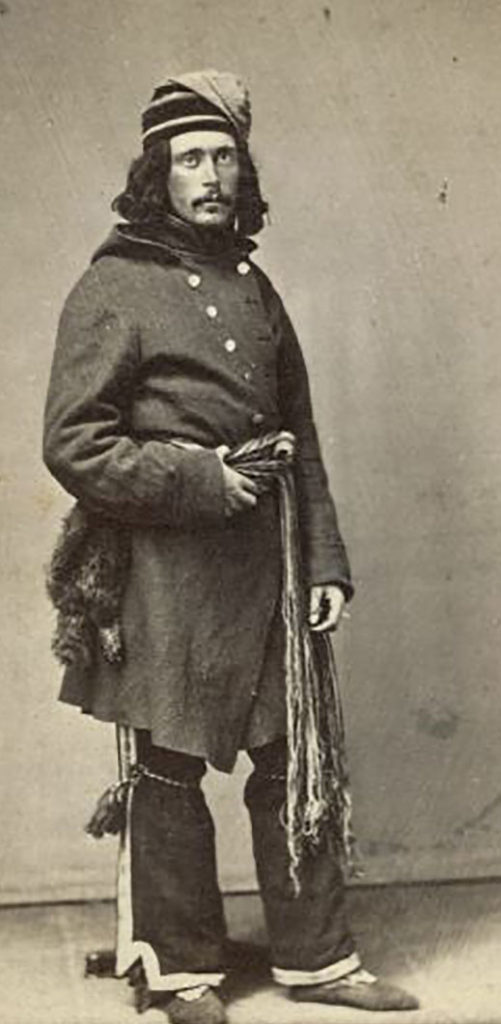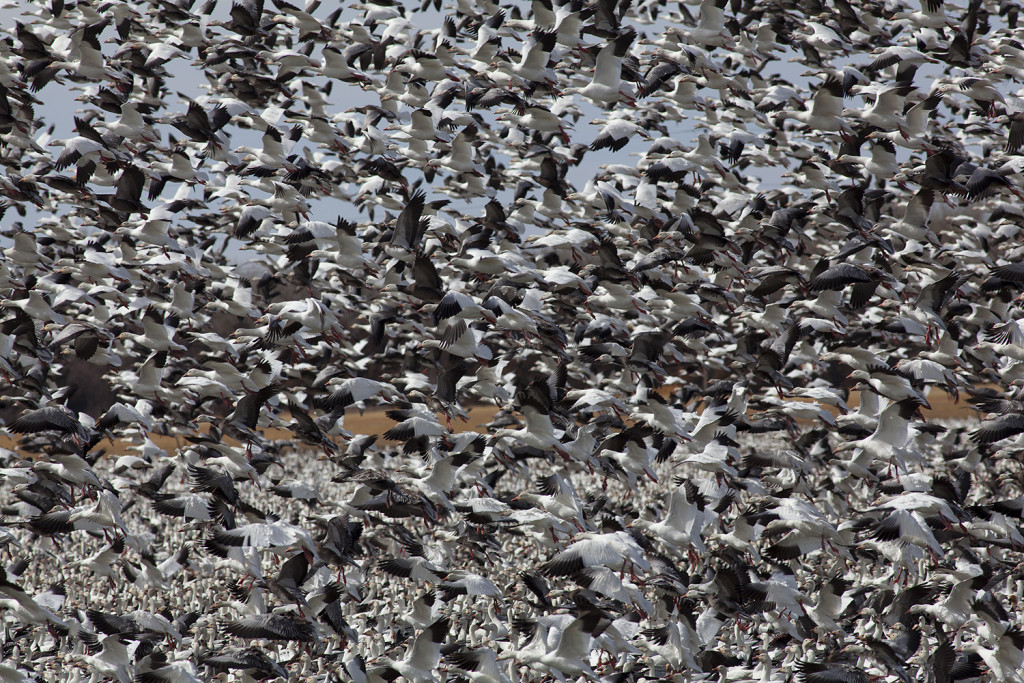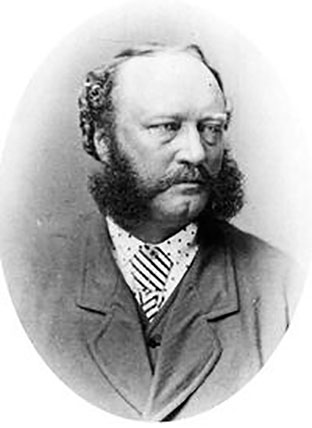
“Shooting the Rapids” by Canadian artist Frances Anne Hopkins, 1879. Courtesy of Library and Archives Canada.
FOR MILLENNIA, THE METHYE PORTAGE CROSSED THE HEIGHT OF LAND THAT SEPARATES THE WATERS OF HUDSON’S BAY FROM THE vast, impossibly remote wilderness of the Mackenzie River drainage. The path was a thoroughfare for native travelers and, for a century, the fur trade. Even today, it’s almost 400 miles north of any settlement an outlander would know; in 1859, it was 2,100 miles of jack pine, mosquitoes, and black flies from the jumping-off point on the northwest shore of Lake Superior.
Not the time or place one would expect a bookish Irishman and an American naturalist to strike up an acquaintance.

Robert Kennicott back from northern Canada in capote and moccasins. Courtesy of the Smithsonian Insitution.
Robert Kennicott arrived on the north end of the Methye Portage on July 24 that year, after a sixty-seven-day trip from Fort William, the Hudson’s Bay Company post on the site of what is now Thunder Bay, Ontario. Waiting for Kennicott’s party was Bernard Rogan Ross, chief trader at the company’s Fort Simpson Post, a mere 600 miles from Methye.
This was no chance encounter. Kennicott had come from his home in northern Illinois as an official representative of the United States Smithsonian Institution. Two years earlier, the leader of the Smithsonian had contacted Sir George Simpson, governor of the Hudson’s Bay Company, to ask for help in obtaining specimens of Arctic mammals and birds.
Simpson had replied most generously: “ The Hudson’s Bay Company are ever ready to render assistance towards the promotion of scientific research in their territory.” He sent copies of the Smithsonian letter to the HBC officers along the Mackenzie River, including Ross, and, in early 1859, sent another letter to company representatives in the northern territories, notifying them that Kennicott would be traveling their direction that summer.
Ross had taken the 1857 call for cooperation with the Smithsonian seriously. As he shook young Kennicott’s hand that day at Methye, he handed the year’s shipment of northern furs over to HBC voyageurs for the return to civilization. Included in those packs were several cases of study skins addressed to the Smithsonian.
Loading Kennicott and the freight for the winter into nine boats, Ross and his men headed back north, down the Clearwater to Lake Athabasca, over a divide to Great Slave Lake, west down the 300 mile-length of the lake to the headwaters of the mighty Mackenzie River, then downstream to the mouth of the Liard River and Fort Simpson. Another fourteen days into the northern wilderness.
This trek was all in a year’s work for the men of the Hudson’s Bay Company. The men who paddled and pulled the freight canoes back and forth across the continent were unimaginably tough, running— running!— over the portages with 180-pound loads, shooting rapids; meeting the wet, the cold, the voracious insects with a song. Most of them were born to the life and knew no other. They had little tolerance for weaklings or shirkers.
The managers were nearly as stout. These were men who would drive a dog sled a hundred miles through temperatures dropping past forty below zero to deliver the mail and chat, men who shrugged off the awful solitude of the Far North, a silence that was known to drive some visitors from civilization to the edge of madness.
When he arrived at Fort Simpson, Kennicott had already spent nearly three months in the rough company of this, one of the world’s most demanding fraternities. The Hudson’s Bay administrators had granted him the nominal position and per diem of a clerk, which gave him a certain official status, but there’s no doubt that he was watched for signs of weakness, for homesickness or impatience with the many discomforts of the trip. It was the hardest kind of initiation, an intense, extended test of strength and will that had broken many men.
By the time winter set in, it was clear that Kennicott had passed the test. In early January of 1860, he drove his own dog team— an arcane skill many white men never mastered— from Fort Simpson to Fort Liard, 260 miles, following the dog team on snowshoes and returning in early March. He learned to shoot a bow and did his best to learn the native languages, a process he found challenging because of the “absence of good interpreters.”
He traveled ceaselessly, by sled and canoe, in search of specimens of mammals and birds, making friends and converts to scientific collecting wherever he went. The winter of 1860-61 found him hunting and trapping at the HBC’s outpost on the upper Yukon River, 200 miles north and west of Fort Simpson. The following May, he joined other members of the post in a spring goose hunt, the meat to be used by the group, the skins to be sent back to the Smithsonian.
“The modus operandi of the hunters is to make a low cabin, or blind of willows, or logs,” he wrote in his journal. “In this the hunter stands, and when he sees a band of geese, imitates their call, when they will, generally, if not too high, and he calls well, turn and come to him. As fast as any geese are killed, they are ‘planted’ near the stand, and when there are a number of these decoys, and a good ‘caller,’ the geese will actually come within twenty feet of the stand.”
During a hunt on Great Slave Lake, someone in Kennicott’s party killed a white goose, barely bigger than a mallard, that lacked the “grinning patch” characteristic of the lesser snow goose. The base of the bill was covered with a rash of bumps not seen in snow geese. Kennicott prepared the skin and shipped it south where it immediately caught the attention of Smithsonian officials and ornithologist John Cassin.
On March 26, 1861, while Kennicott was still in the North, ornithologist John Cassin officially reported the find to science: “the smallest goose known to inhabit North America. Bill strongly warted or carunculated in front and on its sides near and at its base. Entire plumage white.”

Mixed flock of lesser snow geese and Ross’ geese in Nebraska’s Rainwater Basin. (Photo copyright 2016, Chris Madson, all rights reserved)
Cassin recognized that this study skin was confirmation of a report that had been made nearly a century before by Samuel Hearne, another Hudson’s Bay Company man who had made two extensive expeditions into the Coppermine River region of northcentral Canada in the 1780s. Hearne called it the “horned wavy,” “wavy” being a corruption of the native word for “goose.”
With the physical evidence in hand, the scientific community could finally accept Hearne’s report as well as correspondence from Bernard Rogan Ross, who had insisted that this miniature snow goose was its own species. Ross had very probably adopted this opinion because the Dene tribes around Great Slave Lake considered the bird to be different from other geese.
All that was left was to choose a sanctioned name.
If there were justice in the world of taxonomy, the bird would have been called Hearne’s goose. Hearne had encountered the species as early as 1769 and furnished a detailed description in 1795 in his Journey to the Northern Ocean. However, he hadn’t brought back a specimen, the crucial piece of evidence the taxonomists of the time required.
Sixty years later, Kennicott was the man who prepared the skin so that it would survive the trip back to civilization. He was the Smithsonian’s man in the North, a collector of unparalleled energy and talent. The force of his example inspired several of the Hudson’s Bay Company men to begin collecting for the Smithsonian and other scientific institutions. In 1859, the Smithsonian received 208 scientific specimens from the Mackenzie district, all of them collected by Kennicott himself. In 1860, that number jumped to 1,872, of which 572 were Kennicott’s. In 1862, Kennicott was called back to the United States because of his father’s illness. He sent no specimens that year, but the Mackenzie men sent 2,400.
At least twenty-two employees of the Hudson’s Bay Company began collecting for the Smithsonian during Kennicott’s sojourn in the North. James Lockhart, chief trader at the Yukon post and one of Kennicott’s closest friends, contributed more than 1,000 specimens. Roderick McFarlane, an HBC trader on the Anderson River as well as at Fort Simpson, began an impressive collecting career when he met Kennicott, contributing more than 5,700 specimens over the next decade.
All of which is to say that Kennicott deserves a prominent place in the history of North American scientific exploration, not only for the collections he made but for the collections he encouraged. Perhaps even a species with his name attached: Kennicott’s goose has a certain ring. . . .

Bernard Rogan Ross, chief factor at the HBC post, Fort Simpson, NWT, during Kennicott’s stay. Courtesy of the Library of Congress.
Standing in the way of that christening was Bernard Ross, the highest authority the Hudson’s Bay Company had in the Northwest Territories. He was a man of ambition in a place where ambition was particularly hard to fulfill, a voracious reader, member of five scientific and philosophical societies, and an aspiring poet and journalist.
The 1857 letter from the Smithsonian asking for specimens, combined with Kennicott’s arrival, set a fire in Ross’s belly. Beginning with the 1859 shipment of specimens, he took credit for 2,259 specimens sent to the Smithsonian over the next decade. In 1861, he wrote to Spencer Baird at the Smithsonian: “I wish to make myself a name in the scientific world if possible, and I am sure you will do all in your power to gain it for me.”
The lion’s share of the specimens he claimed were actually collected by other men, a fact that rankled some of his subordinates, and it’s unlikely that he actually prepared more than a handful of the skins he sent. Still, he sent more than any of the rest of the company’s men along the Mackenzie, after McFarlane.
He also waived the freight charges for the shipments of specimens and for incoming shipments of collecting materials,, books, and the occasional bottle of whiskey, at least inside the confines of the Mackenzie district. As supportive as the Hudson’s Bay Company had been, this was not something that had been authorized, and it may be that his insistence on shipping under his name may have been an effort to justify the free transport and camouflage it. In 1865, the company discovered the liberties he had taken and fined and reprimanded him for the shipments.
Kennicott realized soon after his arrival at Fort Simpson how important Ross’s support was to the reconnaissance of the Mackenzie region. In 1860, he wrote to Spencer Baird at the Smithsonian: “I found Mr Ross very anxious to send all he could in his own name. . . Postmasters and clerks . . . were to hand over to him all the specimens. . . . As I of course wanted to see all the specimens sent possible— I thought this [a] better policy than to have them given to me.” Baird was quick to understand the situation, and when Cassin examined the Smithsonian’s study skin, Baird suggested that the new species be dubbed “Anser Rossii.” After subsequent decades of wrangling over taxonomic affiliations, the bird has been moved to a different genus and is now known to science as Chen rossii. Ross’s goose.
When Ross heard of the decision in November of 1861, he immediately wrote to Baird: “I am quite flattered at having the snow goose called after me,” he said. “It is about the pleasantest compliment that could be paid me.”
And so Bernard Ross gained the immortality he was so desperate to win. He stayed on with the Hudson’s Bay Company for another ten years, retiring in 1872 and dying quietly two years later in Winnipeg.
Kennicott returned to the north country in 1865 with the Western Union telegraph company’s expedition to run a line through Alaska and across the Bering Strait into Russia. He signed on as “Chief of Explorations,” with the understanding that he could appoint assistants and make extensive collections of the Alaskan flora and fauna.
The expedition was poorly provisioned and badly led by a commander whose only goal was the quickest possible installation of the telegraph line. There was almost no time for collecting; over the winter of 1865-66, the challenge was just trying to stay adequately fed. Kennicott became increasingly discouraged and, on the night of May 13, 1866, suffered an apparent heart attack while walking outside camp. He died alone on the banks of the Yukon River at the age of thirty-one.
It is somewhat ironic that this failed expedition led to the only recognition of Kennicott’s outstanding contributions to the field of ornithology. In March of 1866, one of his subordinates collected a small owl in the rain forest near Sitka. When the specimen was examined back in Chicago, it turned out to be a new species, the western or Kennicott’s screech owl, then classified as Scops Kennicottii. The task of describing the new bird for science fell to Daniel Elliot, curator of zoology at Chicago’s Field Museum. At the end of his technical description, Elliot added this note:
“In bestowing on this owl the name which I trust it is ever destined to bear, I simply express the desire which I am sure is felt by all ornithologists, to render honor to him who, combining the intrepidity of the explorer with the enthusiasm of the naturalist, twice penetrating the forbidding, cheerless districts of the far north, in order to extend the knowledge of his favorite science; and who perished in his early manhood, in the full tide of his usefulness, on the banks of the Yukon. Ornithology has met no greater loss, in these later days, than in the death of Robert Kennicott.”
Kennicott’s colleague William Dall spoke for many of Kennicott’s field companions when he wrote: “He joined to a noble and generous heart an enthusiastic love of nature; defying in the pursuit of knowledge the miasma of the tropics and the rigors of the Arctic winter; manfully enduring isolation, sickness and privation and dying in the field, a martyr to the conscientious discharge of his duty.”
The science of ornithology remembers Kennicott’s dedication and endurance with that single word—kennicottii— in the technical name of a bird that is as little remembered or appreciated as Kennicott himself, but it’s clear from the reaction following his death that his memory was cherished in the hearts of friends from the halls of the Smithsonian to the wilderness of the Yukon. In the end, that may be monument enough for any man.
—————
Leave a Reply
You must be logged in to post a comment.